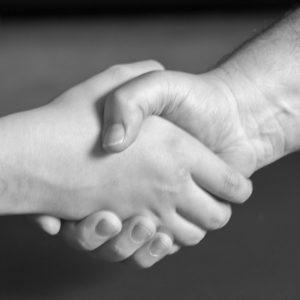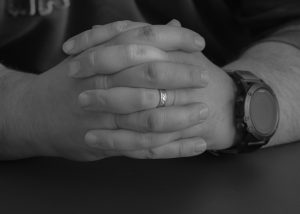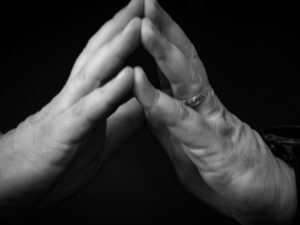Today, I declined a promising sales proposal because I didn’t like the salesperson’s body language. His hand gestures told me about his motives. Learning and practicing positive body language hand gestures changes how people perceive you and how you feel about yourself.
Body language is the outward reflection of your emotions and motivations. It is a scientific fact that your body language gives away your true intentions. Yet, most of us are unaware of the impact of our gestures in our communication. Our gestures, movements and posture can tell one story, while our words tell another. It is essential to learn positive, open gestures to communicate with others and eliminate gestures that may give negative signals.
I first learned about body language as a teenager, when I scooped a book from my mom’s pile of psychology books. Allan Pease’s practical body language book, Signals, is still one of my favourite books in my communications library.
Most of the basic communication gestures are the same all over the world. Much of our body language we learn from our environment and is habitual. Research shows that nonverbal signals impact us five times as much as verbal communication and importantly, when the two are incongruent, we tend to rely on the nonverbal message and may disregard the verbal message.
Let’s look at seven simple hand gesture meanings that can influence your communication with others positively and negatively:
#1 Palm Position
 A valuable way to discover if someone is being open and honest with you is to look for a person’s palm position. An open palm encourages people to be open with you. Allan Pease refers to this as “Palm Power” and when used correctly, can communicate authority and silent, non-threatening command.
A valuable way to discover if someone is being open and honest with you is to look for a person’s palm position. An open palm encourages people to be open with you. Allan Pease refers to this as “Palm Power” and when used correctly, can communicate authority and silent, non-threatening command.
When someone shares honestly and openly, she will appear more credible and likeable simply by displaying open palm gestures in her communication. This is a completely unconscious gesture, one that gives you a feeling or hunch that the other person is telling the truth. You will want to look for the person’s exposed palms when he gives reasons why he cannot listen or act, because only valid reasons are given with exposed palms.
Alternatively, when your palm position is faced down, you will have immediate authority and should be used carefully. This palm position can unconsciously make people feel like you are ordering them with your hands. It is best to also limit using a pointed finger in your communication as this can have a very negative, aggressive effect.
#2 Rubbing Palms Together
When people rub their hands together, they are non-verbally expressing positive expectations. In my case, when I am excited about a future experience, I clap like an excited child. It happens so naturally, even if I wanted to stop it, I don’t think I could. The rubbing of palms together is evident in situations where people are excited for potential success:
- Sales Closing – a salesperson rubs his hands together in expectation of a big sale
- Winning – a dice thrower rubs the dice between his palms as a sign that he expects to win his bet
- Event Speaker Introduction – an event host will rub her hands together when introducing a speaker
Interestingly, the speed at which a person rubs his hands together signals who the person thinks will receive the positive result expected. If the person rubs quickly, he is indicating that you will be the one who benefits from the results. If the speed is slow, unconsciously you will feel the person is being deceptive and the benefits will not serve you.
#3 Handshake Position
 Three attitudes transmit unconsciously with a handshake and they immediately affect the outcome of a face-to-face interaction. By the specific position of your hand in the handshake, you control the nonverbal signal you deliver to the other person.
Three attitudes transmit unconsciously with a handshake and they immediately affect the outcome of a face-to-face interaction. By the specific position of your hand in the handshake, you control the nonverbal signal you deliver to the other person.
- Dominance – You transmit dominance by turning your hand, so your palm faces down in relation to the other person’s palm. This palm down position of your handshake tells the person unconsciously that you wish to take control of the interaction with the other person.
- Submission – You convey submission when your palm is facing up in the handshake position. This is effective when you want to give the other person control or allow him to feel that he is in control. The person with the dominant hand will feel unconsciously as if they can dominate the person just from the handshake! It is important to note however, that health and physical conditions can limit a person’s handshake positions, so it is best to evaluate multiple gesture signals before making assumptions.
- Equality – You transfer equality in a handshake when the both palms are facing each other equally and the position of the palm is vertical. This handshake position tells the person that that you like them and that you will get along well.
#4 Gripping Hands, Arms, Wrists
This posture is effective when you find yourself in a high stress situation. It is an unconscious act of fearlessness. You achieve this posture by exposing your vulnerable stomach, heart and throat regions to others. You place your head up, chin out and one palm grips the other hand behind your back.
When your hand behind your back is gripping your wrist, this is a signal of frustration. It is almost as if it is an attempt by one arm to prevent the other arm from striking out.
The further the hand moves up the back, the angrier the person is becoming. It is this very gesture that coined the term, “get a grip”. By moving your gesture to palm-in-palm position, a calming and confident feeling results.
 #5 Hands Clenched Together
#5 Hands Clenched Together
A person who has his hands clenched, accompanied with a smile, looks confident, but this is not the case. Research concludes the hands clenched gesture is actually a frustration gesture and signals the person is holding back a negative attitude or emotion.
It is also important to pay attention to the height of the clenched hands as this will indicate the strength of a person’s negative mood. The higher the position of the hands, the more you will need to communicate effectively to unlock his fingers, expose his palms and lessen his negativity.
#6 Thumb Display
Thumbs denote strength of character and display dominance, superiority or even aggression. There are several interesting insights for thumb displays:
- Thumbs displayed while fingers grab clothing/strap, with the person’s head tilted up, displays superiority. It is obvious when this thumb position is used if the person gives a contradictory verbal message. It can make the person seem insincere or pompous.
- Thumbs protruding from people’s pockets, including the back pockets, signals a person trying to hide their dominant attitude.
- Thumb thrusters will often rock on the balls of feet to give the impression of extra height.
- Arms folded with thumbs pointing upwards is a signal of a defensive or negative attitude, plus a superior attitude.
- Thumb pointing is a form of ridicule or disrespect for a person.
- It is important to note, that thumb pointing is irritating to most women, particularly when a man does it. It is typically used as a gesture for people a person does not like.
#7 Steepling Hands
 The body language pioneer, Professor Ray Birdwhistell coined the term, “steepling hands”. The fingers of one hand lightly press against the fingers of the other hand and form a church steeple shape. Birdwhistell noted that people who view themselves as reputable and among the elite use minimalist gestures, and tended to use a restricted steeple finger position to demonstrate their confident attitude.
The body language pioneer, Professor Ray Birdwhistell coined the term, “steepling hands”. The fingers of one hand lightly press against the fingers of the other hand and form a church steeple shape. Birdwhistell noted that people who view themselves as reputable and among the elite use minimalist gestures, and tended to use a restricted steeple finger position to demonstrate their confident attitude.
Steepled fingertips have two main positions:
- Raised Steeple – When the fingers are raised in front of the chest, the speaker is giving opinions and thoughts. It is advised to use this position cautiously, as it can convey arrogance or a “know it all” attitude, especially if the person’s head is tilted back.
- Lower Steeple – When the fingers are in the lower steeple position around the waist, the person is typically listening rather than speaking. Interestingly, research indicates that women tend to use the lower steeple position, more often than the raised position.
If the steeple follows a series of other positive gestures, the impact is typically favourable. On the other hand, if the steeple gesture follows a series of negative gestures (arm folding, leg crossing, hand to face gestures), the impact has negative consequences.
People form 90 percent of their opinion about a person in the first ninety seconds of meeting the person. It is essential your body language sends out positive unconscious gestures. Conscious observation and practice of these specific hand gestures will boost your ability to be an influential communicator. Check out my body language and communication training programs, workshops, and bootcamps to improve your communication and connection at work and home!




0 Comments